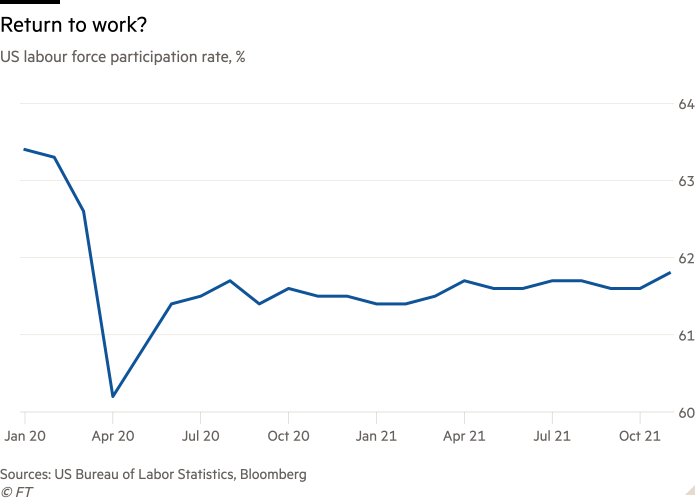A sharp drop in the US unemployment rate has set the stage for the Federal Reserve to accelerate the scaling back of its stimulus programme this month, economists said, giving it greater flexibility to raise interest rates sooner next year if necessary.
The world’s largest economy added 210,000 jobs in November, roughly half the pace that economists expected and well below the previous month.
But significant improvements in the rate of unemployment, which dropped 0.4 percentage points to 4.2 per cent, as well as the number of Americans re-entering the workforce, affirmed expectations that the Fed will proceed in less than two weeks’ time with a more aggressive timeline for withdrawing its support.
“This employment report gives them cover to announce a speedier taper,” said Margaret Kerins, global head of fixed income strategy at BMO Capital Markets. “They need to taper faster so that they can be prepared to lift-off sooner in order to maintain price stability and prevent inflation from becoming entrenched.”
“It’s a risk management approach, and the upside risk of inflation now outweighs the risk to employment,” she added.

Jay Powell, the newly reappointed Fed chair, said in congressional testimony this week that he would support the central bank considering an earlier end to its asset purchase programme than the pace unveiled just last month.
At the last policy meeting in November, the Federal Open Market Committee announced a $15bn reduction or “taper” of the $120bn bond-buying programme, meaning the Fed would cease adding to the size of its balance sheet in June.
Powell expressed his support for possibly ending that process “perhaps a few months sooner” — a sea-change that has clear backing from other Fed officials.
In an interview with the Financial Times on Thursday, Loretta Mester, president of the Cleveland Fed and a voting member on the FOMC next year, said she supports a faster taper so that the central bank has “optionality” to raise interest rates more swiftly to tame inflation.
The Fed has said it will not raise interest rates until it achieves inflation that sustainably averages 2 per cent, and maximum employment.
November’s jobs report showed progress towards the latter goal, said Sarah House, chief economist at Wells Fargo.
“The labour market continues to tighten rapidly,” she said. “Yes, we saw a disappointing increase in the payrolls number . . . but the fact that the unemployment rate continues to decline and participation is increasing does show that we are continuing to move towards maximum employment.”

The so-called labour force participation rate “bounced noticeably”, according to economists at Morgan Stanley, ticking up to 61.8 per cent from 61.6 per cent the previous month. While it is still 1.5 percentage points lower than its pre-pandemic level, it was a welcome development after many months of stagnation as workers were held back by Covid-related concerns and other issues.
The employment-to-population ratio for “prime age” workers, which tracks the percentage of Americans in the 24-to-54 age bracket who have jobs, also made significant headway, rising to 78.8 per cent. That is the highest level since early 2020 and a jump from October’s 78.3 per cent level.
Economists also pointed to the household survey portion of November’s jobs report, which indicated the number of employed rose 1.1m as 594,000 more people joined the labour force. The household survey is often seen as more volatile than the “establishment” survey, which registered much more muted gains, however.
Taken together with the moderate wage gains and the shrinking gap in the unemployment rate between white and black workers, Kristina Hooper, chief global market strategist at Invesco, said the “fairly positive” jobs report keeps the Fed on track to push forward with its plans.
“We will get an accelerated taper in December, especially since the very preliminary anecdotal evidence we are getting about Omicron is that it’s mild,” she said.
“The big part of the Powell pivot is not so much that we have an accelerated taper, but that it [may mean] interest rate hikes sooner than expected especially in light of the Omicron variant.”
Market measures of interest rate expectations, as estimated by Fed funds futures, suggest the central bank will raise rates roughly three times next year. Barclays has pencilled in an adjustment as early as May, while Evercore ISI and Goldman Sachs expect it in June.
Credit: Source link
The post Fall in jobless rate sets stage for swifter taper of Fed stimulus appeared first on News Full Circle.

Post a Comment